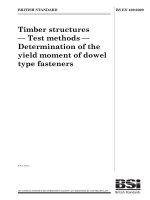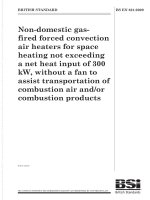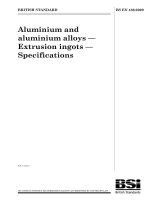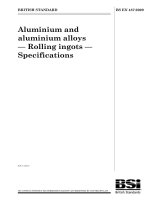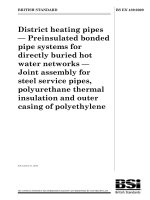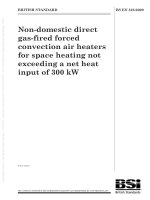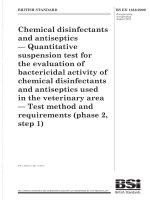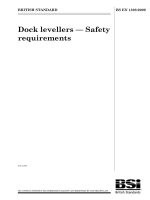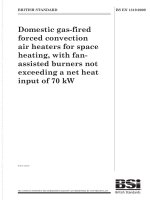Bsi bs en 00723 2009
Bạn đang xem bản rút gọn của tài liệu. Xem và tải ngay bản đầy đủ của tài liệu tại đây (1.43 MB, 16 trang )
BRITISH STANDARD
Copper and
copper alloys —
Combustion method
for determination of
the carbon content on
the inner surface of
copper tubes or fittings
ICS 77.150.30
NO COPYING WITHOUT BSI PERMISSION EXCEPT AS PERMITTED BY COPYRIGHT LAW
BS EN 723:2009
BS EN 723:2009
National foreword
This British Standard is the UK implementation of EN 723:2009. It
supersedes BS EN 723:1996 which is withdrawn.
The UK participation in its preparation was entrusted to Technical
Committee NFE/34, Copper and copper alloys.
A list of organizations represented on this committee can be obtained on
request to its secretary.
This publication does not purport to include all the necessary provisions
of a contract. Users are responsible for its correct application.
Compliance with a British Standard cannot confer immunity
from legal obligations.
This British Standard
was published under the
authority of the Standards
Policy and Strategy
Committee on 31 July 2009
© BSI 2009
ISBN 978 0 580 56377 5
Amendments/corrigenda issued since publication
Date
Comments
BS EN 723:2009
EUROPEAN STANDARD
EN 723
NORME EUROPÉENNE
EUROPÄISCHE NORM
April 2009
ICS 77.150.30
Supersedes EN 723:1996
English Version
Copper and copper alloys - Combustion method for
determination of the carbon content on the inner surface of
copper tubes or fittings
Cuivre et alliages de cuivre - Méthode de détermination par
combustion de la teneur en carbone à la surface interne
des tubes ou des raccords en cuivre
Kupfer und Kupferlegierungen - Verfahren zur Bestimmung
des Kohlenstoffs auf der Innenoberfläche von Kupferrohren
oder Fittings durch Verbrennen
This European Standard was approved by CEN on 19 March 2009.
CEN members are bound to comply with the CEN/CENELEC Internal Regulations which stipulate the conditions for giving this European
Standard the status of a national standard without any alteration. Up-to-date lists and bibliographical references concerning such national
standards may be obtained on application to the CEN Management Centre or to any CEN member.
This European Standard exists in three official versions (English, French, German). A version in any other language made by translation
under the responsibility of a CEN member into its own language and notified to the CEN Management Centre has the same status as the
official versions.
CEN members are the national standards bodies of Austria, Belgium, Bulgaria, Cyprus, Czech Republic, Denmark, Estonia, Finland,
France, Germany, Greece, Hungary, Iceland, Ireland, Italy, Latvia, Lithuania, Luxembourg, Malta, Netherlands, Norway, Poland, Portugal,
Romania, Slovakia, Slovenia, Spain, Sweden, Switzerland and United Kingdom.
EUROPEAN COMMITTEE FOR STANDARDIZATION
COMITÉ EUROPÉEN DE NORMALISATION
EUROPÄISCHES KOMITEE FÜR NORMUNG
Management Centre: Avenue Marnix 17, B-1000 Brussels
© 2009 CEN
All rights of exploitation in any form and by any means reserved
worldwide for CEN national Members.
Ref. No. EN 723:2009: E
BS EN 723:2009
EN 723:2009 (E)
Contents
Page
Foreword ..............................................................................................................................................................3
1
Scope ......................................................................................................................................................4
2
Terms and definitions ...........................................................................................................................4
3
Principle ..................................................................................................................................................4
4
4.1
4.1.1
4.1.2
4.1.3
4.1.4
4.2
4.2.1
4.2.2
4.3
4.3.1
4.3.2
4.4
4.4.1
4.4.2
Preparation of samples and test pieces ..............................................................................................4
Preparatory procedures ........................................................................................................................4
General ....................................................................................................................................................4
Residual carbon content .......................................................................................................................5
Total carbon content .............................................................................................................................5
Potential carbon content .......................................................................................................................5
Preparation of samples .........................................................................................................................5
Tubes ......................................................................................................................................................5
Fittings ....................................................................................................................................................5
Cleaning of sample surfaces ................................................................................................................5
Cleaning of inner surface of sample ....................................................................................................5
Cleaning of outer surface of sample....................................................................................................6
Preparation of test pieces .....................................................................................................................7
Tubes ......................................................................................................................................................7
Fittings ....................................................................................................................................................8
5
5.1
5.2
5.3
Method for carbon content determination ..........................................................................................9
General ....................................................................................................................................................9
Determination of the carbon content ................................................................................................ 10
Determination of the blank value ...................................................................................................... 10
6
Expression of results ......................................................................................................................... 10
7
Calibration ........................................................................................................................................... 11
8
Test report ........................................................................................................................................... 11
Bibliography ..................................................................................................................................................... 12
2
BS EN 723:2009
EN 723:2009 (E)
Foreword
This document (EN 723:2009) has been prepared by Technical Committee CEN/TC 133 “Copper and copper
alloys”, the secretariat of which is held by DIN.
This European Standard shall be given the status of a national standard, either by publication of an identical
text or by endorsement, at the latest by October 2009, and conflicting national standards shall be withdrawn at
the latest by October 2009.
Attention is drawn to the possibility that some of the elements of this document may be the subject of patent
rights. CEN [and/or CENELEC] shall not be held responsible for identifying any or all such patent rights.
This document supersedes EN 723:1996.
In comparison with the first edition of EN 723:1996, the following significant technical changes and one
significant editorial change were made:
improvement of the accuracy of the method;
extension of the scope of the standard to fittings of copper alloys;
simplification by limitation to only one method for carbon content determination, namely that of infrared
absorption spectrometry:
[Method using tetrabutylammonium hydroxide (HTBA) and Method of determination by measurement of
differential electrical conductivity (coulometric) deleted];
simplification by limitation to only one cutting method for tubes with diameters exceeding the furnace
diameter by deletion of the "longitudinal cutting method";
change of Clause 2 "Normative References" into "Bibliography" with renumbering.
According to the CEN/CENELEC Internal Regulations, the national standards organizations of the following
countries are bound to implement this European Standard: Austria, Belgium, Bulgaria, Cyprus, Czech
Republic, Denmark, Estonia, Finland, France, Germany, Greece, Hungary, Iceland, Ireland, Italy, Latvia,
Lithuania, Luxembourg, Malta, Netherlands, Norway, Poland, Portugal, Romania, Slovakia, Slovenia, Spain,
Sweden, Switzerland and the United Kingdom.
3
BS EN 723:2009
EN 723:2009 (E)
1
Scope
This European Standard specifies a combustion method for determining the carbon content, if any, on the
inner surface of tubes of copper or fittings of copper or copper alloys.
This standard applies only to seamless, round copper tubes as specified for example in EN 1057 and
EN 13348 or fittings of copper or copper alloys as specified in EN 1254 (all parts).
2
Terms and definitions
For the purposes of this document, the following terms and definitions apply:
2.1
residual carbon
CR
carbon present in the chemical form of elemental carbon
2.2
potential carbon
CP
carbon present in the chemical form of organic compounds
EXAMPLE
Organic compounds: oils, greases, etc.
2.3
total carbon
CT
sum of residual carbon and potential carbon
3
Principle
Combustion of the carbon present on the inner surface of a tube or fitting sample, carried out at a given
temperature in an oxygen flow.
Determination, by infrared absorption spectrometry, of the residual or total carbon content, or both, by
measurement of the carbon dioxide generated. Calculation of potential carbon content is by subtraction of the
residual carbon content from the total carbon content.
4
Preparation of samples and test pieces
4.1
Preparatory procedures
4.1.1
General
Carry out the procedures in 4.1.2, 4.1.3 or 4.1.4 depending on the carbon to be determined and taking
account of the following precautions:
a)
metal cutting tool shall be free from protective paint;
b)
clamps shall be flat and consist of copper, aluminium, steel or an alternative material. Alternative
materials shall not be detrimental to their cleanliness;
4
BS EN 723:2009
EN 723:2009 (E)
c)
all tools and implements used for cutting or clamping samples shall be degreased before sample
preparation;
d)
degreasing shall be done by wiping with a lint-free cloth containing absorbed tetrachloroethylene,
trichloroethylene or trichloroethane or, because of potential for environmental harm, other solvents of
equivalent performance, e.g. acetone. These solvents shall also be used for cleaning/immersion of
samples where appropriate;
e)
suitable protective gloves should be used to ensure skin contact with the surface under test is avoided;
f)
between the cleaning operation and the combustion operation, the test pieces shall be kept in a noncontaminating environment, such as a clean laboratory or in a desiccator containing sodium hydroxide
pellets. The tests shall be completed within approximately 5 h of cleaning the sample, or if not, the
sample shall be re-cleaned.
4.1.2
Residual carbon content
a) prepare samples (see 4.2);
b) clean inner and outer surface of sample (see 4.3.1 and 4.3.2);
c) prepare test pieces (see 4.4).
4.1.3
a)
b)
c)
Total carbon content
prepare samples (see 4.2);
clean outer surface of sample (see 4.3.2);
prepare test pieces (see 4.4).
4.1.4
Potential carbon content
Prepare separate samples and test pieces following the procedures in 4.1.2 and 4.1.3.
4.2
4.2.1
Preparation of samples
Tubes
Cut a sample approximately 30 cm long from a tube, using a metal-cutting saw or a pipe cutter. Deburr the
outer and inner edges of the sample ends, using a smooth file or a trimming blade, take care that any burrs
removed do not fall into the bore of the tube.
4.2.2
Fittings
Select sufficient fittings from the batch in order to be able to cut test pieces from them having a minimum total
2
internal surface area of 10 cm .
4.3
4.3.1
Cleaning of sample surfaces
Cleaning of inner surface of sample
The following steps shall be performed in a fume cupboard. Immerse the sample, for a minimum of 2 min in an
agitated bath of boiling chlorinated solvent, for example, analytical grade trichloroethylene or trichloroethane,
that shall be used as reference in case of dispute ensuring that the solvent baths are kept topped up, such
that the sample remains totally immersed in the solvent. Immerse the sample in a second, boiling solvent bath
for at least 30 s.
5
BS EN 723:2009
EN 723:2009 (E)
Remove the sample from the bath and place it vertically under a fume hood or on a grease-free plate in an
oven operating at a temperature of at least 80 °C for a minimum of 60 s, until the solvent has totally
evaporated.
Refresh both baths periodically, as appropriate, in accordance with written internal procedures.
4.3.2
Cleaning of outer surface of sample
4.3.2.1
General
Degrease the outside surface of the sample by wiping with a clean, lint-free, solvent-containing cotton cloth,
taking care to ensure that no fibres remain on the sample after wiping.
Clean the sample by chemical cleaning method, see 4.3.2.2, or for tubes in R250 and R290 material
conditions 1) only, the alternative mechanical cleaning method, see 4.3.2.3, except in cases of dispute or
preparation for blank value determination, may be used.
4.3.2.2
4.3.2.2.1
a)
Chemical cleaning
Sealing
For annealed tubes only:
Squashing/flattening a 20 mm (approx.) portion of the tube extending from one end, between clamps (see 4.1)
placed between the jaws of a vice. The squashed end is then folded over and also squashed/flattened against
the adjacent, 20 mm (approx.) length of tube, again using clamps (see 4.1) fixed between the jaws of a vice.
This method shall be used for reference testing.
b)
For tubes or fittings:
Seal one tube end or all fitting ends by inserting appropriately-sized, silicone or neoprene plugs.
NOTE
If necessary, the ends of tubes in annealed material condition should firstly be re-rounded using an
appropriate, degreased re-rounding tool, in order to obtain a leak-tight seal with the plug.
4.3.2.2.2
Cleaning
Place the degreased sample in a clean beaker containing fresh diluted nitric acid for half starting from 50 %
concentrated nitric acid. The temperature of the acid shall be at least 20 °C and for handling reasons, care
has to be taken to control the exothermic reaction, if necessary by cooling the beaker.
a)
For tubes:
The beaker shall contain sufficient solution to cover between 75 mm and 125 mm of the length of the sample
(the smaller the diameter of the tube being tested, the greater the depth of immersion required to ensure a
sufficiently covered surface area).
b)
For fittings:
The beaker shall contain a sufficient quantity of solution to cover the sample. Refresh the acid bath weekly or
after preparation of about forty samples (whichever is the sooner).
1)
6
see EN 1173 for the explanation of R250 and R290.
BS EN 723:2009
EN 723:2009 (E)
Ensure that the sample remains in the acid solution for at least 30 s so that copious quantities of brown fumes
(NO2) are expelled. This step of operation shall be performed in a fume cupboard.
Withdraw the sample from the acid solution and rinse thoroughly with deionised water.
Transfer the sample to a bath containing boiling deionised water for a duration between 30 s and 60 s, which,
before use shall have been boiled for approx. 5 min to ensure a complete degassing of the water, or rinse the
sample with hot (min. 50 °C) running water for at least 30 s. Take care to ensure that the useful part of the
sample is fully immersed in the water bath. Due to an uptake of CO2 from the air, refresh the deionised water
every day or after the preparation of about forty samples (whichever is sooner).
Remove the sample from the bath and place it vertically under a fume hood or on a grease-free plate in an
oven operating at a temperature of at least 80 °C for a minimum of 60 s, until the water has totally evaporated
or let it dry on air.
4.3.2.3
Mechanical cleaning
Hold the tube in a vice and remove all traces of the outer surface in the area to be tested, using a degreased
file.
Alternatively, a thin layer from the outer surface may be removed by turning on a lathe using a tool with a
degreased tip.
All tools used for mechanical cleaning shall be free of organic contamination. The tools shall not be used for
other mechanical operation.
4.4
Preparation of test pieces
4.4.1
4.4.1.1
Tubes
General
Carry out the procedure given in 4.4.1.2 or 4.4.1.3, depending on the tube diameter, and taking account of the
precautions described in 4.1.
4.4.1.2
Tubes with diameters not exceeding the furnace diameter
From the cleaned sample, cut and discard a 2,5 cm length, from one end which, in the case of a chemically
cleaned outer surface, shall be from the plugged or flattened end of the tube (having firstly removed the plug
from the tube end if appropriate).
Measure the required length of tube using a clean measuring device to yield an internal surface area between
2
2
20 cm and 25 cm .
Cut off the required length using either a clean, square-cut auto-saw used only for such purposes or a
degreased, fine-toothed hacksaw, avoiding overheating the sample. If the test piece is longer than the zone of
incandescence of the combustion device described in 5.1 c), cross-cut the test piece into two, in order that
both pieces may be fed simultaneously into the zone of incandescence. Take care to ensure that the cut is
square. If using an auto-saw, take also care to ensure that all surfaces with which the tube is in contact are
thoroughly degreased. When filing and cutting tubes, take care to ensure that the section of tube being held in
position (e.g. between the jaws of a vice) is not excessively distorted.
Determine the internal surface area of the test piece from its mean internal diameter and mean length,
measured to an accuracy of ± 0,1 mm.
NOTE
If the cross-cut leads to a loss of length, it should be taken into account for the surface area determination.
7
BS EN 723:2009
EN 723:2009 (E)
4.4.1.3
Tubes with diameters exceeding the furnace diameter
Prepare the sample as described in 4.4.1.1.
2
If a test piece of internal surface area of at least 20 cm can be obtained by flattening, carry out the flattening
operation between the jaws of a vice equipped with aluminium or alternative material clamps previously
degreased using trichlorethylene or trichloroethane. The alternative material for the clamps shall not be
detrimental to their cleanliness.
4.4.2 Fittings
4.4.2.1
General
Depending on size, a test piece might be:
a)
one complete fitting;
b)
part of one fitting;
c)
several fittings.
2
The internal surface area of the test piece shall be at least 10 cm .
Prepare test piece(s) by one of the following procedures and afterwards keep the test piece(s) taking account
of the precautions described in 4.1.
4.4.2.2
Determination of the internal surface area of the test piece
Determine the internal surface area of the test piece by the most appropriate of the methods given in a), b) or
c) as follows:
a)
by calculation:
Ai = d i × π × l
(1)
where
Ai
is the internal surface area;
di
is the internal diameter;
l
is the length.
This method is considered to be satisfactory when a simple shape is involved i.e. straight coupling.
b)
by comparison: use a transparent graticule having ruled squares of a known surface area.
Section the fitting selected as a test piece along its longitudinal axis.
For copper fittings only, flatten the sample between the jaws of a vice equipped with clamps.
Place the transparent graticule in close contact with the inner surface of the test piece.
Count the number of squares relating to the surface to obtain a close approximation of the internal
surface area of the section. A number of sections may be required to make up an adequate test area.
c)
8
For copper fittings only, by press cutting: use a press tool to produce a shaped test piece. This method
will produce test pieces of a consistent surface area.
BS EN 723:2009
EN 723:2009 (E)
2
NOTE
Circular test pieces of 15,96 mm diameter have a surface area of 2 cm . Alternative shapes are acceptable if
an accurate surface area can be determined.
4.4.2.3
Fittings able to fit into the furnace
Prepare the test piece using the cleaned samples as described in 4.4.2 and 4.3.2.2.2.
4.4.2.4
Fittings unable to fit into the furnace
If the furnace diameter is not large enough to accommodate the whole fitting, proceed in accordance with a) or
b) for fittings of copper alloys and for fittings of copper proceed in accordance with a), b) or c) as follows:
a)
flattening method
If a test piece can be obtained by flattening, carry out the flattening operation between the jaws of a vice
equipped with clamps.
d) sectioning method
Select a section of a fitting, a whole fitting or several fittings to obtain the requested internal surface area
(see 4.4.2.1). Cut the piece(s) longitudinally into two parts, using a degreased saw blade, and fold the two
parts, one onto the other. This folding may be done between the jaws of a vice equipped with clamps.
e) press cut pieces (not applicable to fittings of copper alloys)
Section the fitting selected as a test piece, along its longitudinal axis and flatten it between the jaws of a
vice equipped with clamps.
Place the flattened test piece in a suitable equipment having a cutting tool fitted. Press cut discs out of the
flattened section/sections to make up the surface area required.
5
Method for carbon content determination
5.1
General
Carry out the combustion in a reaction pipe of quartz with flowing oxygen having minimum purity of 99,99 %.
Lower purity oxygen may be used if the equipment has an internal purification system able to yield 99,99 %
purity oxygen for the purposes of the analysis.
The combustion device generally includes, successively from oxygen inlet:
a)
a system for oxygen supply and purification which can guarantee a purity of at least 99,99 %;
b)
a purification furnace (pre-combustion) comprising a reaction pipe of quartz filled with copper oxide which
shall permit a temperature of 450 °C to 500 °C to be maintained;
1)
2)
a trap for H2O;
a trap for CO2;
c)
a waiting chamber for the test piece;
d)
a combustion chamber with a reaction pipe of quartz and tubular furnace (about 600 mm length) which
shall permit a temperature of at least 800 °C to be maintained.
NOTE
The hot zone is only a part of the reaction pipe of quartz.
9
BS EN 723:2009
EN 723:2009 (E)
5.2
Determination of the carbon content
Before carrying out the test, ensure that the time elapsed after cleaning has not exceeded 5 h, see 4.1.
Direct determination of the carbon content by automatic analysis of infrared absorbance of generated carbon
dioxide, using a furnace temperature of 800 °C for 3 min for tubes and fittings of copper and of 550 °C for
fittings of copper alloys. For routine testing of tubes and fittings of copper, shorter analysis time scales and/or
higher combustion temperatures can be used if it can be demonstrated that all carbon present is detected
within the test cycle. However, for reference testing a furnace temperature of 800 °C and analysis time of
3 min shall be used. Correct the measured carbon value for the blank value when appropriate.
The time of analysis shall be established in such a way that the complete signal from the detector is recorded.
2
Accuracy of the method is expected to be ± 0,01 mg/dm .
5.3
Determination of the blank value
5.3.1
General
The blank value shall be determined at commencement of a test or sequence of tests.
When determined as indicated below, the blank value will include all uncertainties related to the preparation of
the test pieces and to the apparatus blank.
For the calculation of the blank value use the total surface area of the blank sample (inner and outer surface
area).
The blank value is the mean of the values obtained for two test pieces.
2
Satisfactory preparation gives a blank value of not greater than 0,02 mg/dm . If greater values are obtained,
the test piece preparation and apparatus blank shall be reviewed.
5.3.2
5.3.2.1
Procedure
Selection of the test piece for tubes
Take a previously analysed sample, of the most commonly analysed dimension. Ensure that the sample is
cooled to room temperature.
5.3.2.2
Selection of the test piece for fittings
Take fittings or part fittings prepared as described in 4.4.2. The cleaning operation shall be performed as
described in 4.3.2.2.2.
6
Expression of results
2
The value of carbon content shall be expressed, in mg/dm , as the arithmetical mean of the values obtained
for two equivalent test pieces; residual (CR), potential (CP) or total carbon (CT), as appropriate.
If one test result exceeds the limit specified in the relevant standard then a further test shall be carried out
using samples from the same tube or batch of fittings. If this further test gives an acceptable result then the
earlier result shall be disregarded.
10
BS EN 723:2009
EN 723:2009 (E)
7
Calibration
The applicable method is described in 5.2.
a)
The test apparatus shall be calibrated at commencement of testing, or at a minimum of once a day if in
continual use, with carbon dioxide having minimum purity of 99,99 %, according to the machine
manufacturer’s instructions. Alternatively, calibration may be performed using samples of known carbon
content by assay (D-mannitol or powder containing carbon of known concentration, using a furnace
analysis temperature of 800 °C for a duration of 3 min. All other machine parameters shall be as per the
machine manufacturer’s recommendations for this type of analysis.
b)
The accuracy of the daily calibration and the stability of the device shall be checked at regular intervals
using samples of D-mannitol or powder containing carbon of known concentration according to 5.2.
The check shall be performed:
1)
2)
3)
at least twice a year;
after ca. 1 000 measurements when in continual use;
or whenever it seems appropriate.
The nominal value of the carbon of the D-mannitol or powder containing carbon samples shall be within the
accuracy of the test method according to 5.2.
All other machine parameters shall be in accordance with the manufacturer’s recommendations for this type of
analysis.
8
Test report
A test report shall contain at least the following information:
a)
identification of the test pieces;
b)
reference to this European Standard (EN 723);
c)
product designation of the product tested;
d)
results;
e)
any unusual characteristics noted during the determination;
f)
any operation not included in this European Standard or in the document to which reference is made or
regarded as optional;
g)
date of the test and/or date of preparation or of affixing the signature of the test report;
h)
Signature of the responsible person.
11
BS EN 723:2009
EN 723:2009 (E)
Bibliography
[1]
EN 1057, Copper and copper alloys — Seamless, round copper tubes for water and gas in sanitary
and heating applications
[2]
EN 1173, Copper and copper alloys — Material condition designation
[3]
EN 1254 (all parts), Copper and copper alloys — Plumbing fittings
[4]
EN 13348, Copper and copper alloys — Seamless, round copper tubes for medical gases or vacuum
12
BS EN 723:2009
This page has been intentionally left blank
BS EN 723:2009
BSI - British Standards Institution
BSI is the independent national body responsible for preparing British
Standards. It presents the UK view on standards in Europe and at the
international level. It is incorporated by Royal Charter.
Revisions
British Standards are updated by amendment or revision. Users of British
Standards should make sure that they possess the latest amendments or
editions.
It is the constant aim of BSI to improve the quality of our products and services.
We would be grateful if anyone finding an inaccuracy or ambiguity while using
this British Standard would inform the Secretary of the technical committee
responsible, the identity of which can be found on the inside front cover. Tel:
+44 (0)20 8996 9000. Fax: +44 (0)20 8996 7400.
BSI offers members an individual updating service called PLUS which ensures
that subscribers automatically receive the latest editions of standards.
Buying standards
Orders for all BSI, international and foreign standards publications should be
addressed to Customer Services. Tel: +44 (0)20 8996 9001. Fax: +44 (0)20 8996
7001 Email: You may also buy directly using a debit/credit
card from the BSI Shop on the Website />In response to orders for international standards, it is BSI policy to supply the
BSI implementation of those that have been published as British Standards,
unless otherwise requested.
Information on standards
BSI provides a wide range of information on national, European and
international standards through its Library and its Technical Help to Exporters
Service. Various BSI electronic information services are also available which
give details on all its products and services. Contact Information Centre. Tel:
+44 (0)20 8996 7111 Fax: +44 (0)20 8996 7048 Email:
Subscribing members of BSI are kept up to date with standards developments
and receive substantial discounts on the purchase price of standards. For details
of these and other benefits contact Membership Administration. Tel: +44 (0)20
8996 7002 Fax: +44 (0)20 8996 7001 Email:
Information regarding online access to British Standards via British Standards
Online can be found at />Further information about BSI is available on the BSI website at http://
www.bsigroup.com.
Copyright
BSI Group
Headquarters 389
Chiswick High Road,
London, W4 4AL, UK
Tel +44 (0)20 8996 9001
Fax +44 (0)20 8996 7001
www.bsigroup.com/
standards
Copyright subsists in all BSI publications. BSI also holds the copyright, in the
UK, of the publications of the international standardization bodies. Except as
permitted under the Copyright, Designs and Patents Act 1988 no extract may
be reproduced, stored in a retrieval system or transmitted in any form or by any
means – electronic, photocopying, recording or otherwise – without prior written
permission from BSI.
This does not preclude the free use, in the course of implementing the standard,
of necessary details such as symbols, and size, type or grade designations. If
these details are to be used for any other purpose than implementation then the
prior written permission of BSI must be obtained.
Details and advice can be obtained from the Copyright and Licensing Manager.
Tel: +44 (0)20 8996 7070 Email:
